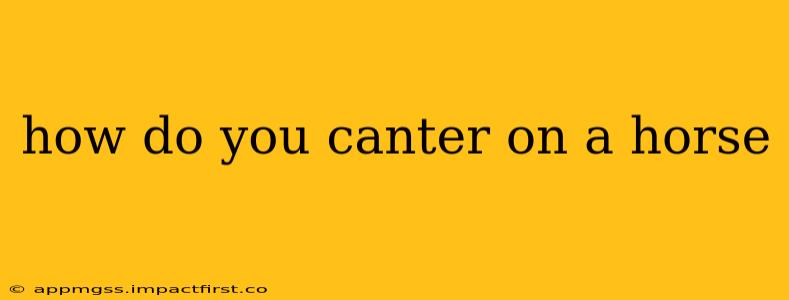Cantering is a thrilling and graceful three-beat gait, a crucial skill for any rider to master. It’s a natural progression from the walk and trot, requiring balance, coordination, and a good understanding of your horse. This guide breaks down the process, answering common questions riders have about achieving a smooth and controlled canter.
What are the Different Types of Canters?
Before we delve into the "how," let's clarify the types of canters. You'll typically hear about the right lead canter and the left lead canter. This refers to which of the horse's legs leads the gait. A right lead canter means the horse's right hind leg pushes off first, followed by the left hind, then the right fore, and finally the left fore. The left lead is the reverse. Choosing the correct lead is vital for balance and efficiency. Incorrect leads can make the canter feel uncomfortable and unbalanced for both horse and rider.
How Do I Prepare My Horse for the Canter?
Preparing your horse is just as important as the actual transition. A well-prepared horse will be more likely to canter smoothly and willingly.
- Warm-up: A proper warm-up is crucial. Start with walking and gradually progress to trotting, ensuring your horse is loose and responsive to your aids. This prepares their muscles and increases their responsiveness.
- Establish a steady rhythm at the trot: Before attempting the canter, ensure your horse is trotting steadily and consistently. Avoid rushing this stage; a stable trot is essential for a smooth transition.
- Check your posture and position: Ensure you are sitting correctly with a balanced, independent seat. Correct posture is vital for effective communication with your horse and maintaining stability during the canter.
How Do I Actually Get My Horse to Canter?
The exact cues for the canter transition vary depending on your horse's training and your instructor's preferred method. However, common cues include:
- Light Seat Aids: Gently rise slightly in your seat and then subtly sink back down again, just as you would for a half seat during a trot.
- Leg Aids: Apply a gentle but firm pressure with your outside leg (the leg on the side you want the horse to lead with) just behind the girth. Simultaneously, you may need to use a slight inward pressure on your inside leg as well, to keep the horse from leaning.
- Rein Aids: You may subtly shorten or tighten the reins to help your horse understand your request. However, you don't want to pull back heavily, instead use a gentle contact.
- Combination of Aids: Most riders combine these aids, using a combination of seat, leg, and rein cues. The timing and intensity of each aid will be determined by your horse.
What if My Horse Doesn’t Canter?
If your horse isn't responding, don't get frustrated. There could be several reasons:
- Lack of training: The horse may not be properly trained to canter on command.
- Rider position: Your seat, leg, or rein aids might be unclear or inconsistent.
- Physical issues: A physical problem could be affecting your horse's ability to canter.
- Confidence issues: Your horse might be lacking confidence in your cues or in the canter transition itself.
If you're having trouble, it's always best to seek guidance from a qualified instructor. They can assess your and your horse's technique, identify any issues, and provide tailored instruction.
How Do I Maintain the Canter?
Maintaining a consistent and controlled canter relies on:
- Balanced seat: Maintain a balanced, independent seat, allowing your body to move with the horse's motion without interfering.
- Light aids: Use subtle leg and rein aids to maintain the rhythm and impulsion.
- Correct lead: Ensure your horse is maintaining the correct lead.
How Do I Slow Down and Stop from the Canter?
Transitions out of the canter should be equally smooth. Use your aids gradually:
- Slowing down: Applying slight pressure on your inside rein with your outside leg behind the girth.
- Stopping: Applying more consistent pressure on the reins, while simultaneously using your leg aids to maintain the connection with the horse. This should transition smoothly into a trot and then a walk, culminating in a halt.
What are Common Canter Mistakes?
Riders often encounter the following issues:
- Losing the balance: This can cause jerky transitions, or even lead to falls.
- Using excessive rein contact: This can hinder the horse's balance and impulsion.
- Inconsistent aids: Unclear signals confuse the horse and result in an uneven canter.
- Incorrect lead: This leads to an uneven and inefficient gait.
Addressing these errors requires practice and guidance from an experienced instructor.
Learning to canter is a process that requires patience, practice, and professional instruction. Remember to prioritize safety, clear communication with your horse, and a consistent approach to training. With dedication, you'll soon be enjoying the thrill of this beautiful three-beat gait.
